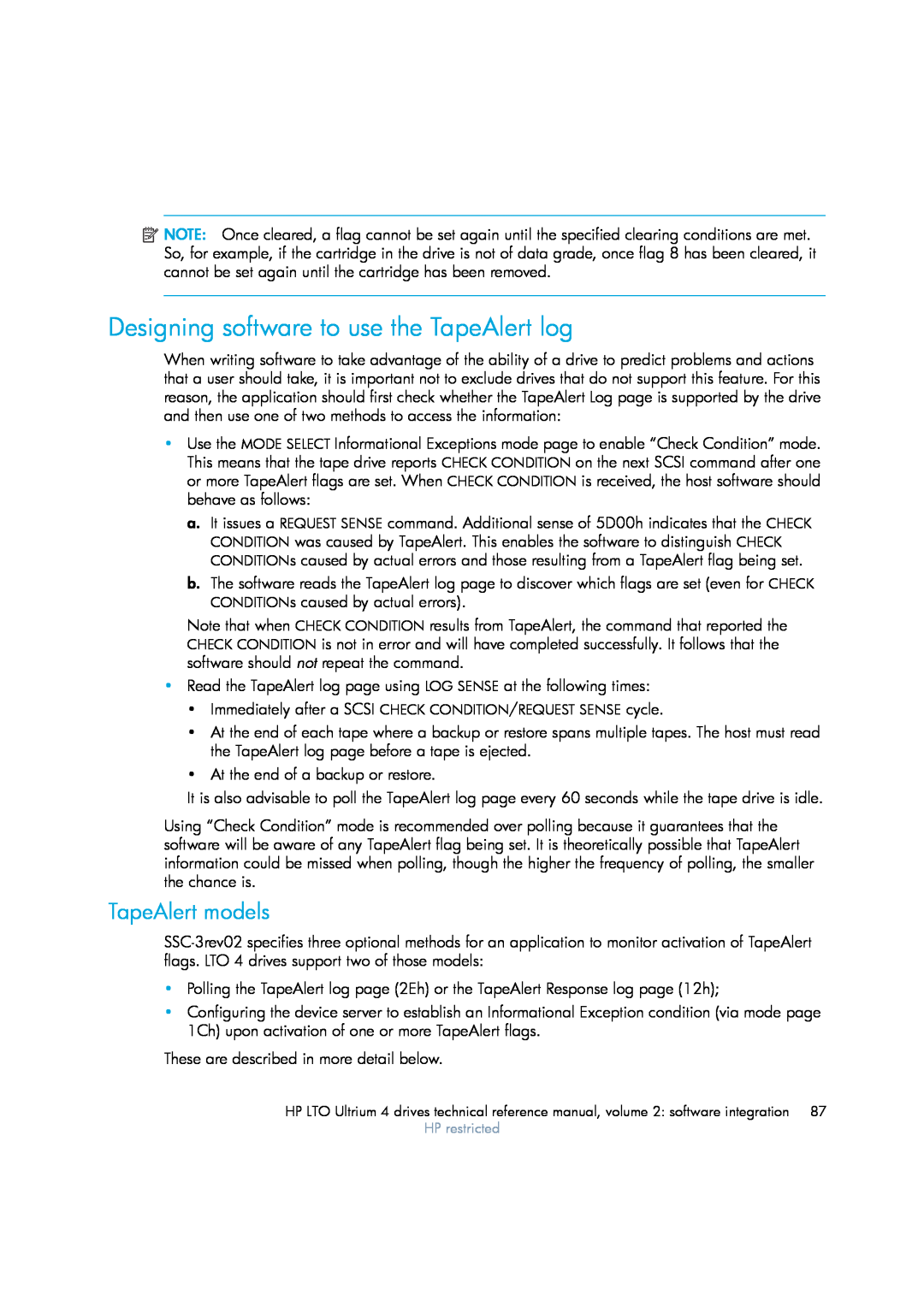HP restricted
volume 2 software integration
LTO 4 FC, SCSI and SAS drives
HP LTO Ultrium tape drives technical reference manual
Legal and notice information
3 Use of tapes
Contents
1 Designing backup applications
2 Configuration and initialization
4 Factors affecting performance
5 Supporting Ultrium features
7 Exception handling
6 Sense keys and codes
HP restricted
Drives-general
Related documents
Documentation map
Documents specific to HP Ultrium drives
Interface
Installation and configuration
Operation
Cartridges
Dealing with errors
Maintenance and troubleshooting
General documents and standardization
LTO Ultrium features
Large data transfer size
1 Designing backup applications
Non-immediate commands
Optimizing performance
Monitoring tape use
Cleaning tape heads
Managing the use of tapes
Information in Cartridge Memory
Displaying drive information
Design goals for LTO backup applications
Diagnostic logs
TapeAlert
Include the capability to download firmware
2 Configuration and initialization
Inquiry string recovery
Operating system drivers
Example
16 Configuration and initialization
SCSI protocol, regardless of transport or interface type
Support for additional LUN
Enabling additional LUN support
Supporting additional LUNs
18 Configuration and initialization
LTO cartridge memory
Using Cartridge Memory attributes
Using MODE SENSE
3 Use of tapes
Tape status and capacity
Finding the remaining capacity
Interpreting Log Sense data
Using the SET CAPACITY command
Command descriptor block
CDB fields
New additional sense codes and TapeAlert flags
Changes to SCSI commands
WORM media
How WORM media works
Re-writing media labels
Error Usage page
ERASE commands rejected
SET CAPACITY command
Using CM to check tape integrity
Behavior with a missing or inconsistent EOD value
Unique media identifier
Responding to Cartridge Memory data
Load count
Barcode support
Corrective action
RWW retry counts
Ensuring the recommended minimum transfer sizes
4 Factors affecting performance
Ways of optimizing performance
Detecting the drive’s speed
Media type identification
Using Cartridge Memory instead of tape headers
Using the Performance Log page for diagnosing problems
Time-out values
Recommended support of log pages
Factors affecting performance
Host-related factors
makes sense to split heavily used FC cards across separate PCI busses
Example
Recommendation
where possible or a reasonably sized RAID system. More disks means
Do not interleave write commands with other commands, such as READ
Drive-related factors
Format-related factors
Page
34 Factors affecting performance
Further information
5 Supporting Ultrium features
Cartridge Memory LTO-CM
Automation interface
Automation/Device Interface ADI
Automation Control Interface ACI
Modes of usage through ACI
Slave to a library controller
ACI command set
ACI commands that affect drive streaming performance
SCSI pass-through mode
Backward compatibility
New features in ACI
SCSI command
Encryption support
42 Supporting Ultrium features
Further details
Supporting the ACI protocol
Recommended ACI time-out values
Treatment of reserved fields
Recommended power-up sequence
Recommended load-unload configuration
Upgrading the drive firmware
Firmware upgrade via tape
Recommended Get Drive Status polling frequency
ACI protocol communications retry
Handling irregular cartridges
Firmware upgrade via the primary host interface
Firmware upgrade via ACI
Library firmware upgrade via tape
Unreadable data cartridge
Cleaning cartridge HP-configured or Universal
Expired cleaning cartridge HP-configured or Universal
Non-HP Ultrium 1 cleaning cartridge
Cartridge cannot be loaded
Valid firmware upgrade cartridge
Data cartridge with unreadable CM
Cartridge fails to seat or load
Is there separate firmware for drives intended to go into libraries?
Frequently asked questions
Cleaning
Invalid firmware upgrade cartridge
Resetting using the ACIRSTL line
Backup software
Resetting drives
Resetting via the ACI Reset command
Buffer size at EW-EOM
Accessing Cartridge Memory without threading the tape
Controlling data compression
Other mode page information
52 Supporting Ultrium features
Rewind on reset
Write delay time
Partition size
Console Message
6 Sense keys and codes
Sense keys-actions to take
Action
error to the calling application
“3h-MEDIUM ERROR” on page 62 . Also see the Media Access
For additional sense codes, see “3h-MEDIUM ERROR” on
log the error, terminate I/O to the drive, and pass the appropriate
Console Message
Action
Console Message
Action
page
reached, unable to fit
Additional sense codes-actions to take
Physical
End-of-Tape
0h-NO SENSE
2h-NOT READY
1h-RECOVERED ERROR
60 Sense keys and codes
The software must issue a LOAD before media access
LUN not accessible, port in
The command cannot be executed because the specified
mechanism tests are being executed. When the tests are
3h-MEDIUM ERROR
A READ , SPACE , WRITE or WRITE FILEMARKS command
62 Sense keys and codes
and the drive. Based on this, ask the user to clean the
Send a console message that an unrecovered error on
64 Sense keys and codes
Send a message to the console indicating that there is
66 Sense keys and codes
The current command such as READ, SPACE, REWIND
4h-HW ERROR
5h-ILLEGAL REQUEST
A MODE SELECT parameter list sent to the drive contains
68 Sense keys and codes
32 initiators to register, using PERSISTENT RESERVE OUT
6h-UNIT ATTENTION
persistent reservation using the PERSISTENT RESERVE OUT
allowed to execute. In other words, some commands can
Action
A SET DEVICE IDENTIFIER command has been successful
service action removed all reservations and the persistent
A PERSISTENT RESERVE OUT command was executed
WRITE BUFFER or MAINTENANCE OUT command
7h-DATA PROTECTION
Action
8h-BLANK CHECK
Bh-ABORTED COMMAND
READ BUFFER command
related to a missing EOD data set. The most likely cause
Dh-VOLUME OVERFLOW
A WRITE or WRITE FILEMARKS command has encountered
76 Sense keys and codes
4. Allow the user to reset devices
Typical escalation procedure
1. Retrieve fault information
3. Allow the user to try recovery
Supporting TapeAlert
Monitoring the condition of the drive and media
Type
Flags
Page
Page
Page
Page
Page
Page
Page
TapeAlert models
Designing software to use the TapeAlert log
Reading the TapeAlert log
TapeAlert polling usage model
TapeAlert informational exception usage model
One-Button Disaster Recovery OBDR
Responding to the ‘Clean’ LED
Supporting OBDR
Requirements for drivers and logical device managers
Providing pass-through mode
Glossary
see ”read-while-write”
Index
Page
Page
HP restricted
